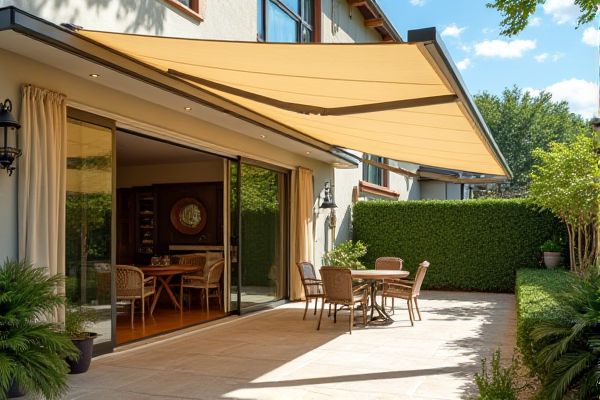
Retractable awnings offer flexibility by allowing you to extend or retract the canopy based on weather conditions, providing adjustable shade and protection, whereas stationary awnings are fixed structures that offer consistent coverage without the option to modify their position. Discover which type best suits your outdoor space and lifestyle needs by exploring the full comparison in the rest of this article.
Table of Comparison
| Feature | Retractable Awning | Stationary Awning |
|---|---|---|
| Flexibility | Can be extended or retracted based on weather and preference | Fixed position, always provides shade |
| Installation | Typically more complex, may require professional installation | Simple installation, often DIY-friendly |
| Cost | Higher initial investment due to mechanism complexity | Generally more affordable upfront |
| Maintenance | Requires periodic maintenance of retracting mechanism | Low maintenance, fewer moving parts |
| Durability | Good, but moving parts may reduce lifespan | Highly durable with less mechanical failure risk |
| Sun Protection | Adjustable coverage as needed | Constant coverage, no adjustment |
| Weather Resistance | Can be retracted during storms to prevent damage | Prone to damage if exposed to harsh weather constantly |
| Aesthetic Options | Wide range of styles, fabrics, and patterns available | Available in various styles but limited by fixed design |
Introduction to Retractable vs Stationary Awnings
Retractable awnings offer adjustable shade and protection with the ability to extend or retract according to sunlight and weather conditions, providing versatility for outdoor spaces. Stationary awnings are fixed structures designed for permanent coverage, delivering consistent shelter and enhancing architectural aesthetics. Choosing between the two depends on factors such as space flexibility, durability, and desired maintenance levels.
Key Differences Between Retractable and Stationary Awnings
Retractable awnings offer flexibility by allowing you to extend or retract the fabric as needed, providing adjustable shade and protection from the elements. Stationary awnings are fixed in place, delivering consistent coverage and durability with minimal maintenance. Your choice depends on the desired level of control and permanence for outdoor shading solutions.
Durability and Longevity: Which Awning Lasts Longer?
Retractable awnings offer flexibility with their ability to be retracted during harsh weather, reducing exposure to sun and rain, which enhances their durability and longevity compared to stationary awnings. Stationary awnings, while sturdier due to fixed installation and often constructed with heavy-duty materials, endure constant environmental exposure, which can shorten their lifespan over time. Your choice depends on whether you prioritize adjustable protection or a robust, permanent fixture for lasting outdoor coverage.
Installation Process: Retractable vs Stationary Awnings
Retractable awnings require a more complex installation process involving secure mounting brackets, motorized or manual retraction systems, and precise alignment to allow smooth operation. Stationary awnings feature a simpler installation, typically mounted using fixed brackets or frameworks that do not move, resulting in fewer components and faster setup times. Proper installation by professionals ensures durability and functionality for both awning types, but retractable models demand more technical expertise due to their mechanical parts.
Maintenance Requirements and Considerations
Retractable awnings require regular maintenance such as cleaning the fabric, checking the mechanical parts, and lubricating the moving components to ensure smooth operation and prevent damage. Stationary awnings generally need less frequent upkeep but may require periodic inspection for fabric wear, frame rust, and debris accumulation. Your choice depends on your willingness to perform or invest in ongoing maintenance versus opting for a more permanent, lower-maintenance solution.
Cost Comparison: Initial Investment and Long-Term Value
Retractable awnings typically require a higher initial investment, ranging from $800 to $2,500, due to their complex mechanisms and motorization options, while stationary awnings cost between $300 and $1,000 depending on materials. Retractable models offer long-term value by providing adjustable shade and protection, which can extend fabric lifespan and reduce maintenance costs. Stationary awnings, though less expensive upfront, may incur higher repair or replacement expenses over time as they are exposed continuously to weather elements.
Aesthetics and Design Flexibility
Retractable awnings offer superior design flexibility, allowing you to extend or retract the fabric based on your outdoor needs, enhancing both functionality and aesthetic appeal. Stationary awnings provide a fixed, durable structure with classic lines that complement traditional architecture but lack the adaptability that modern spaces often require. Choosing a retractable awning can elevate your outdoor living area by pairing dynamic style with customizable shade options, ensuring your space remains visually appealing year-round.
Weather Protection and Adaptability
Retractable awnings provide superior adaptability by allowing users to extend or retract the cover based on weather conditions, offering flexible protection from sun, rain, and wind. Stationary awnings offer consistent, fixed shelter that excels in durability and continuous weather resistance but lack the ability to adjust coverage. Choosing between the two requires balancing the need for customizable weather protection with the desire for permanent structural stability.
Energy Efficiency and Shade Performance
Retractable awnings offer superior energy efficiency by allowing you to control the amount of sunlight entering your space, reducing cooling costs during hot months and maximizing natural warmth in cooler seasons. Stationary awnings provide consistent shade and protection, effectively lowering indoor temperatures but lack the flexibility to adjust for changing sun angles, which can impact their overall shading performance. For optimal energy savings and customized shade, retractable awnings adapt to your needs more effectively than fixed, stationary options.
Which Awning is Best for Your Home or Business?
Retractable awnings offer versatility and control, allowing users to extend or retract the shade based on weather conditions, making them ideal for dynamic sun exposure management in homes or businesses. Stationary awnings provide consistent, durable protection with minimal maintenance, suited for areas requiring permanent shade or weather shielding. Choosing the best awning depends on factors like desired flexibility, climate considerations, and long-term usage needs.
 homyna.com
homyna.com